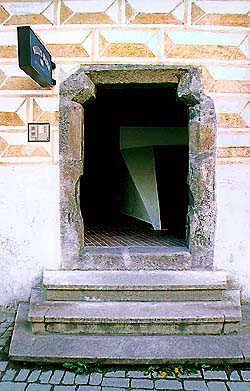Kájovská No. 62
Description of the Building:
A two-storey corner building with a saddle roof, parallel to the
street. The house used to abut on today\'s non-existing Kájovská
town gate - inner. The main front of the house, facing Kájovská
street, is covered with yellow-white letter type sgraffito on the
ground and first floors. The windows are skirted with a rare
ornamental sgraffito band. On the ground floor is a Gothic portal
with skiving. The other front walls lack the sgraffito decoration,
only band cornices are present. The rear facade (facing the river)
has all odd arcades on the third floor broken by windows.
Architectural and Historical Development:
The house was built onto the town gate and town walls in the late
Gothic period. It was reconstructed in the Rennaissance period and
the upper floor was added in 1820. In 1848 the aisle with an odd
archade was built in the direction of the Vltava. In about 1960 a
public passage through the house was built, which destroyed and
devaluated a part of the ground floor. The passage was walled-up
during the reconstruction of the ground floor in 1995. In the
following year an extensive renovation of the sgraffito facade and
roof was carried out.
Significant Architectural Features:
Valuable ornamental sgraffito bands that skirt the windows facing
Kájovská street. On the side wall of the building is a visible
print of the original inner town gate - Kájovská gate, which used
to be situated between the houses No. 62 and 169 until 1842, when
it was knocked down.
History of the House Residents:
The first owner of the house is mentioned at the beginning of the
16th century, when it belonged to a butcher Matěj Mikš. From 1517
to 1565, when the house was bought by a tailor Pankrác Fischer
called the tailor from Kájovská gate, it was kept by several
maltsters.  At the end of the 16th
century the house was owned by a weaver Lorenc Reichenschleger, who
is mentioned there even during the first years of the 17th century.
In 1648 a tailor Lukáš Jungbauer moved there and lived there
probably until 1694. In 1751 the house was shortly kept by a
shoemaker Leopold Schebl and in the same year a dyer Zikmund Weiss
moved there. From 1763 an innkeeper Wolfgang Wagner moved to the
house, followed by the family of Mayers, who owned the house even
in the first half of the 19th century.
At the end of the 16th
century the house was owned by a weaver Lorenc Reichenschleger, who
is mentioned there even during the first years of the 17th century.
In 1648 a tailor Lukáš Jungbauer moved there and lived there
probably until 1694. In 1751 the house was shortly kept by a
shoemaker Leopold Schebl and in the same year a dyer Zikmund Weiss
moved there. From 1763 an innkeeper Wolfgang Wagner moved to the
house, followed by the family of Mayers, who owned the house even
in the first half of the 19th century.
Present Use:
Besides the office of the Travel Agency Vltava, the Bed and
Breakfast Vltavaand Porcela Plus are situated here.
Photographs:
In 1996 a photo documentation was made showing the outer state of
the building before and after the reconstruction of the facade.



